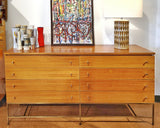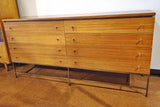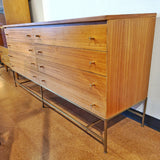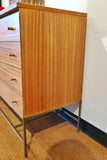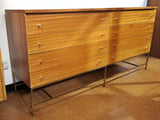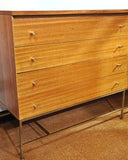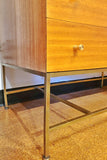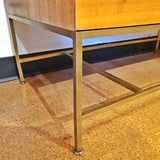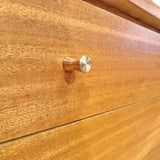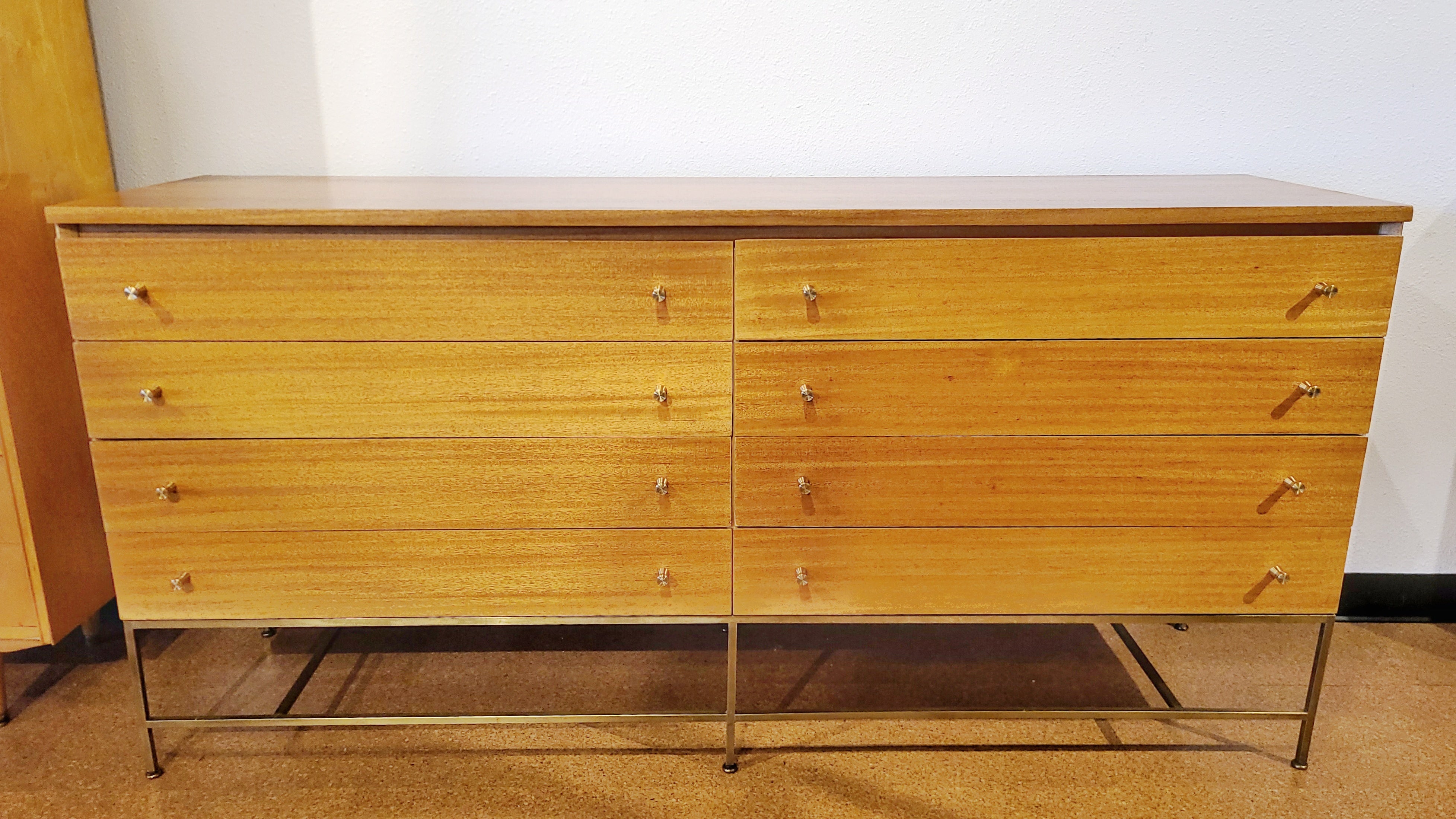
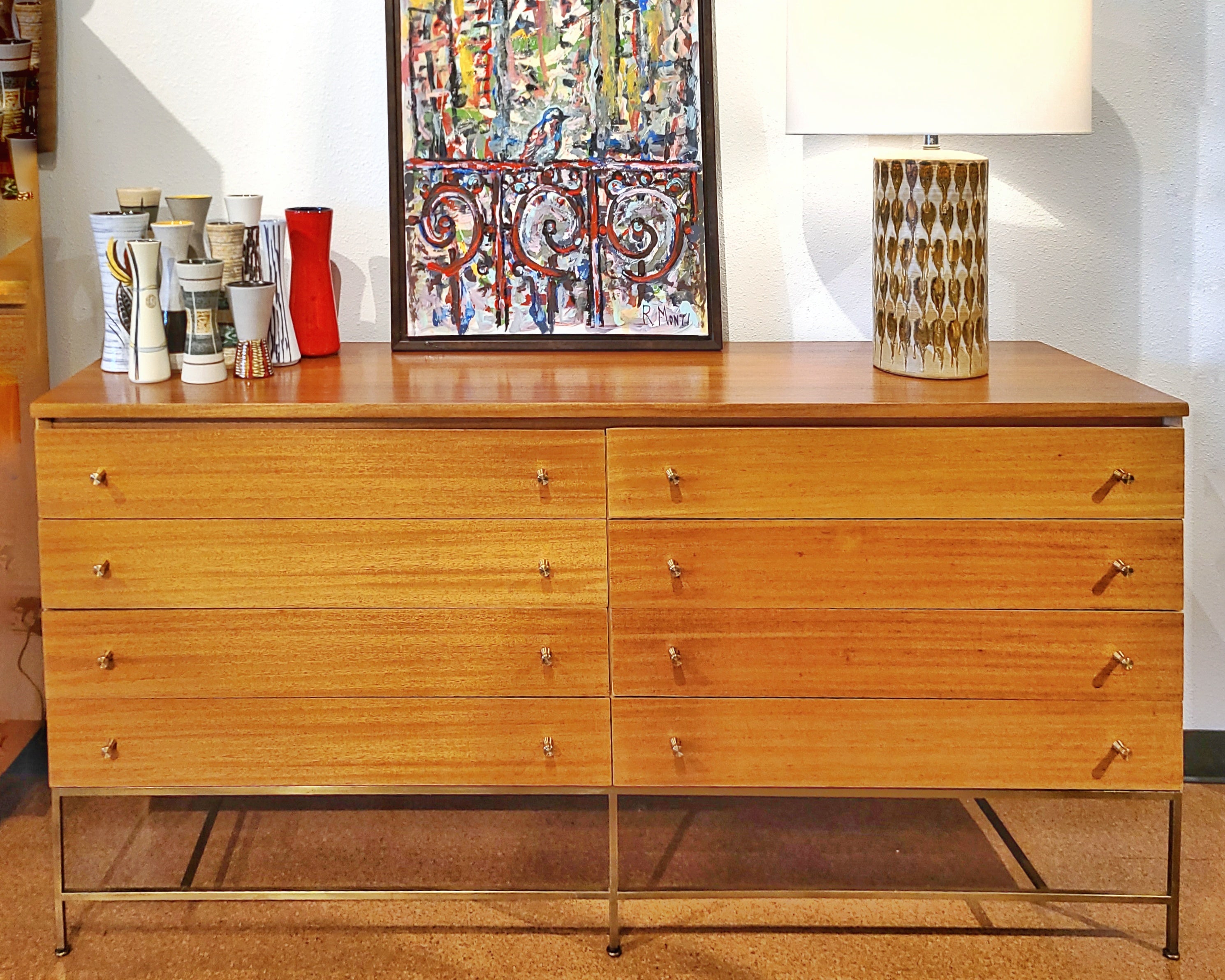
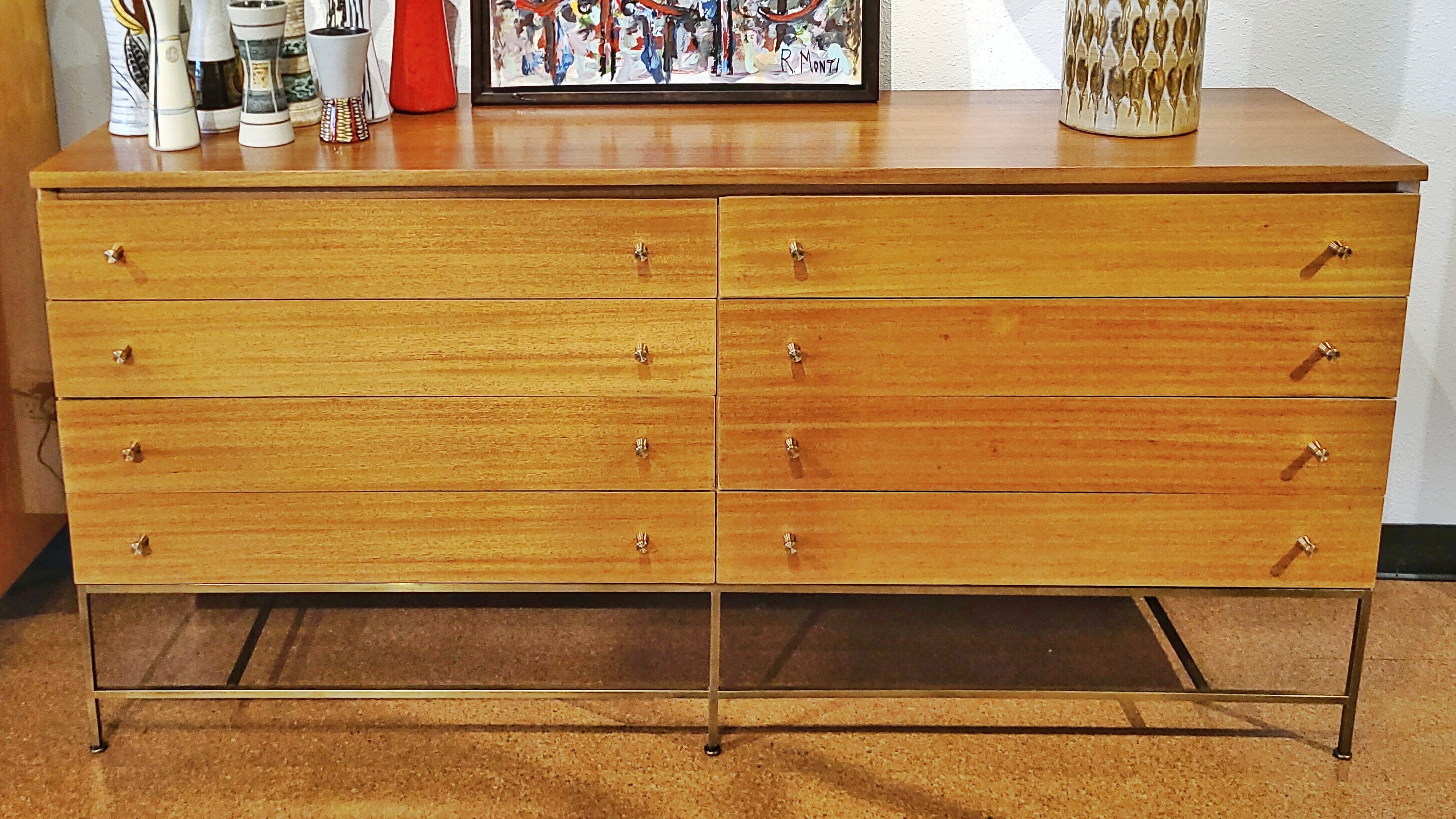
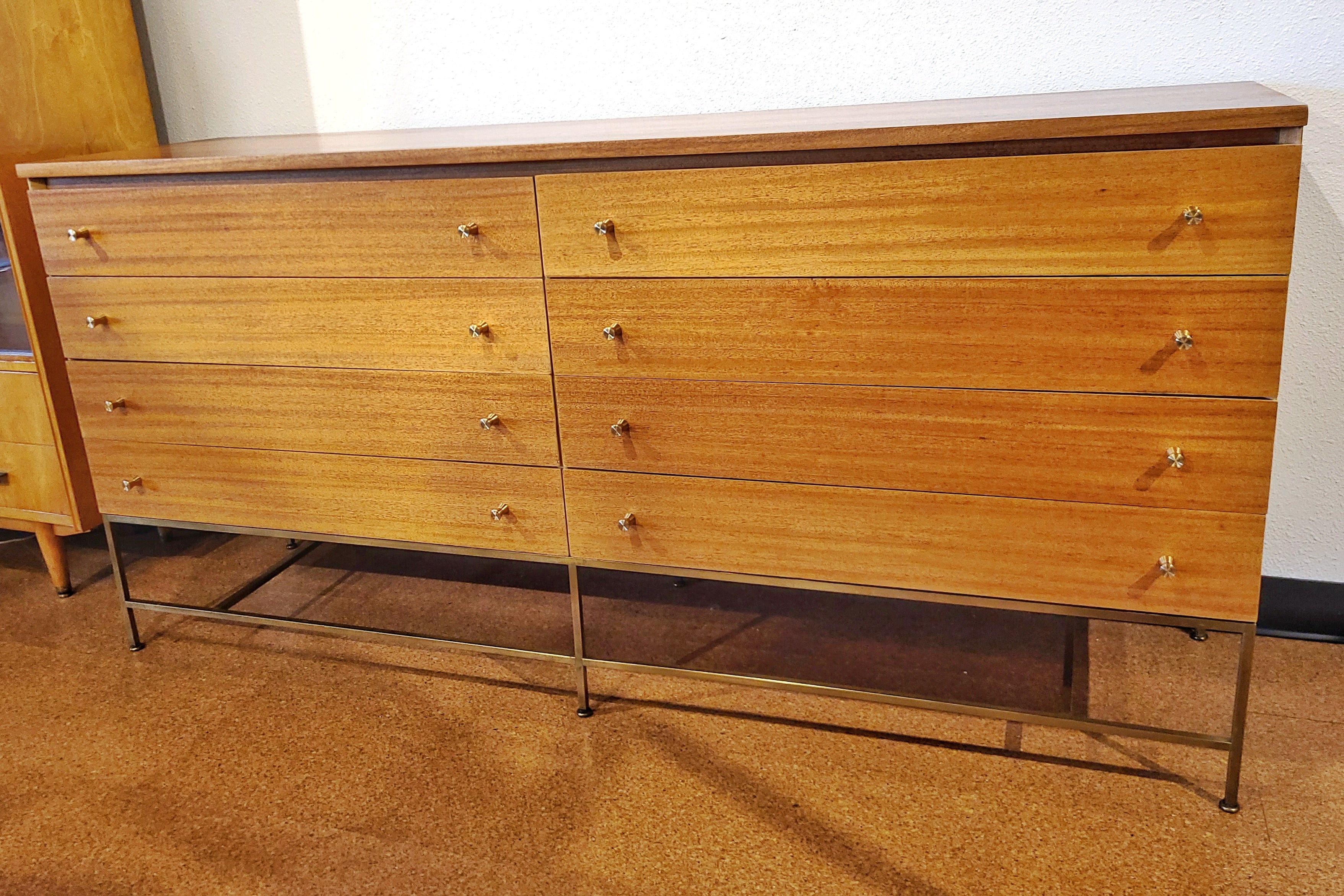
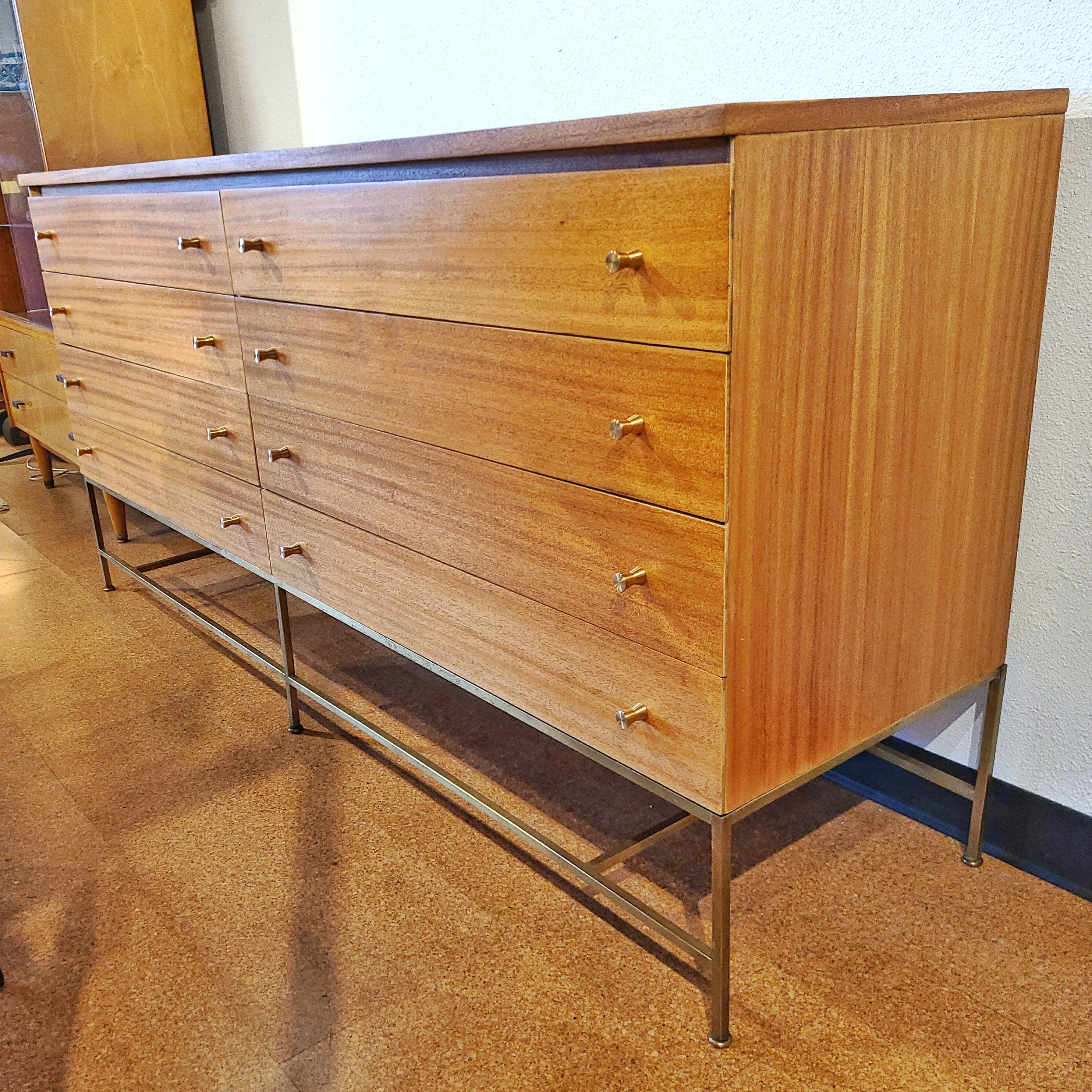
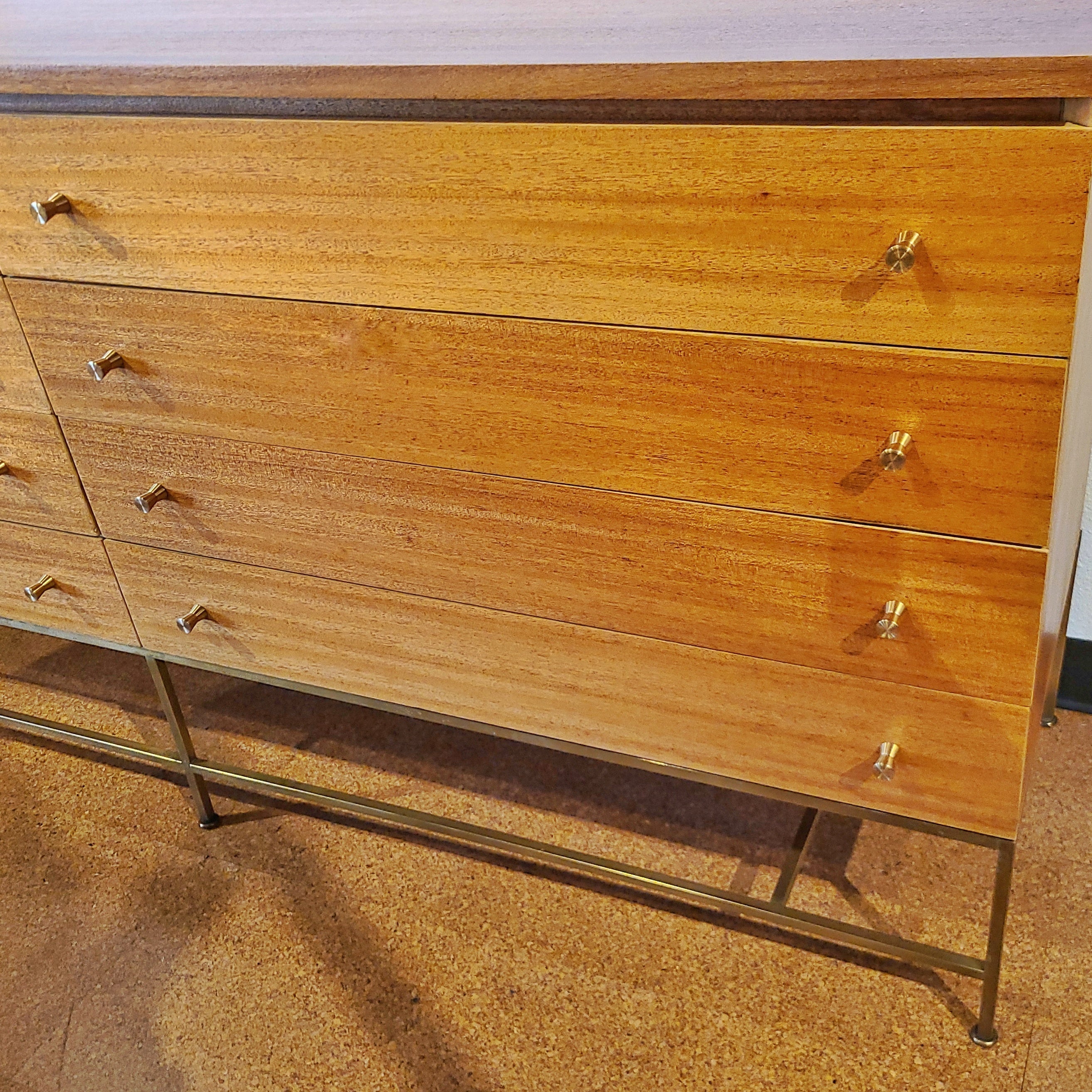
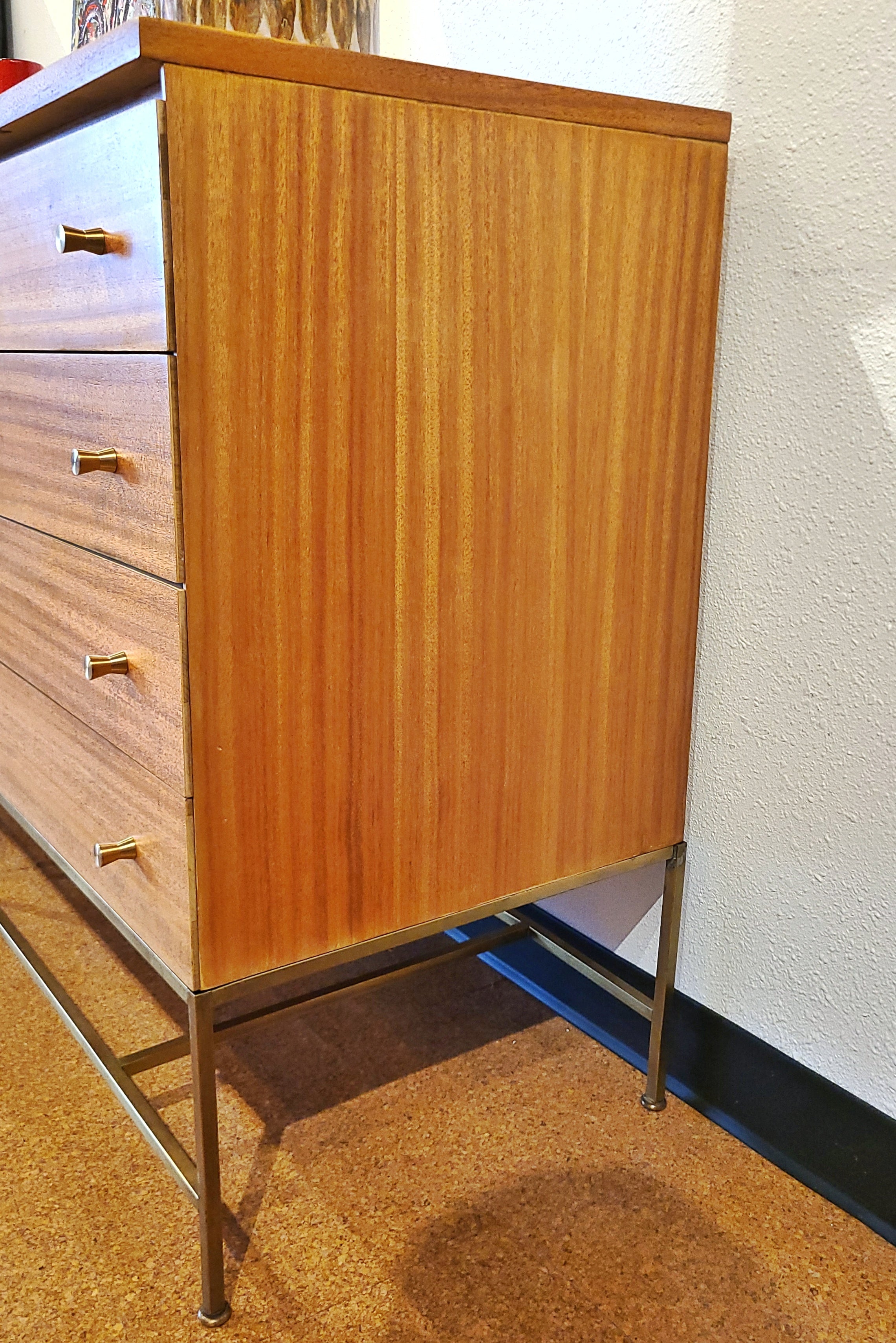
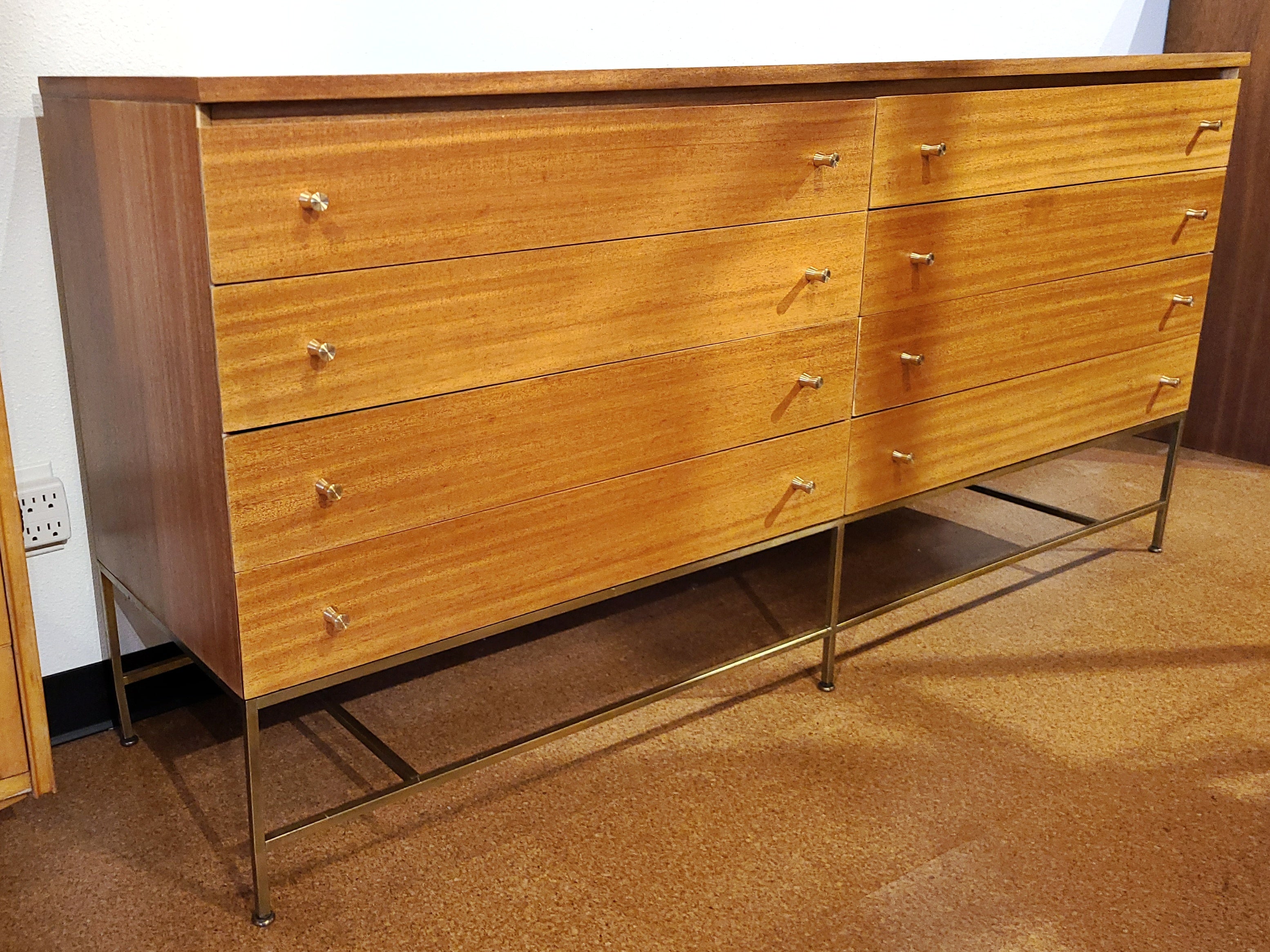
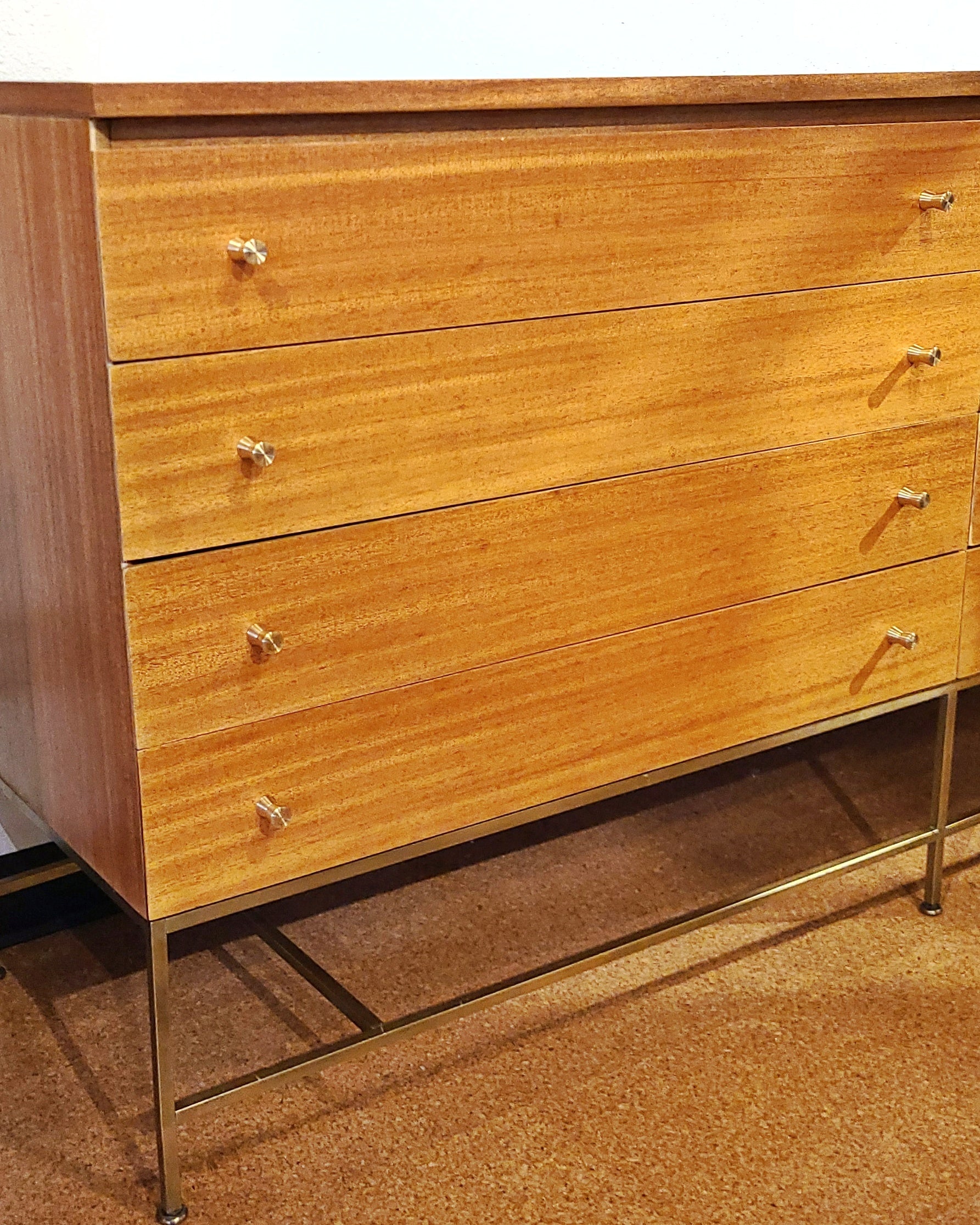
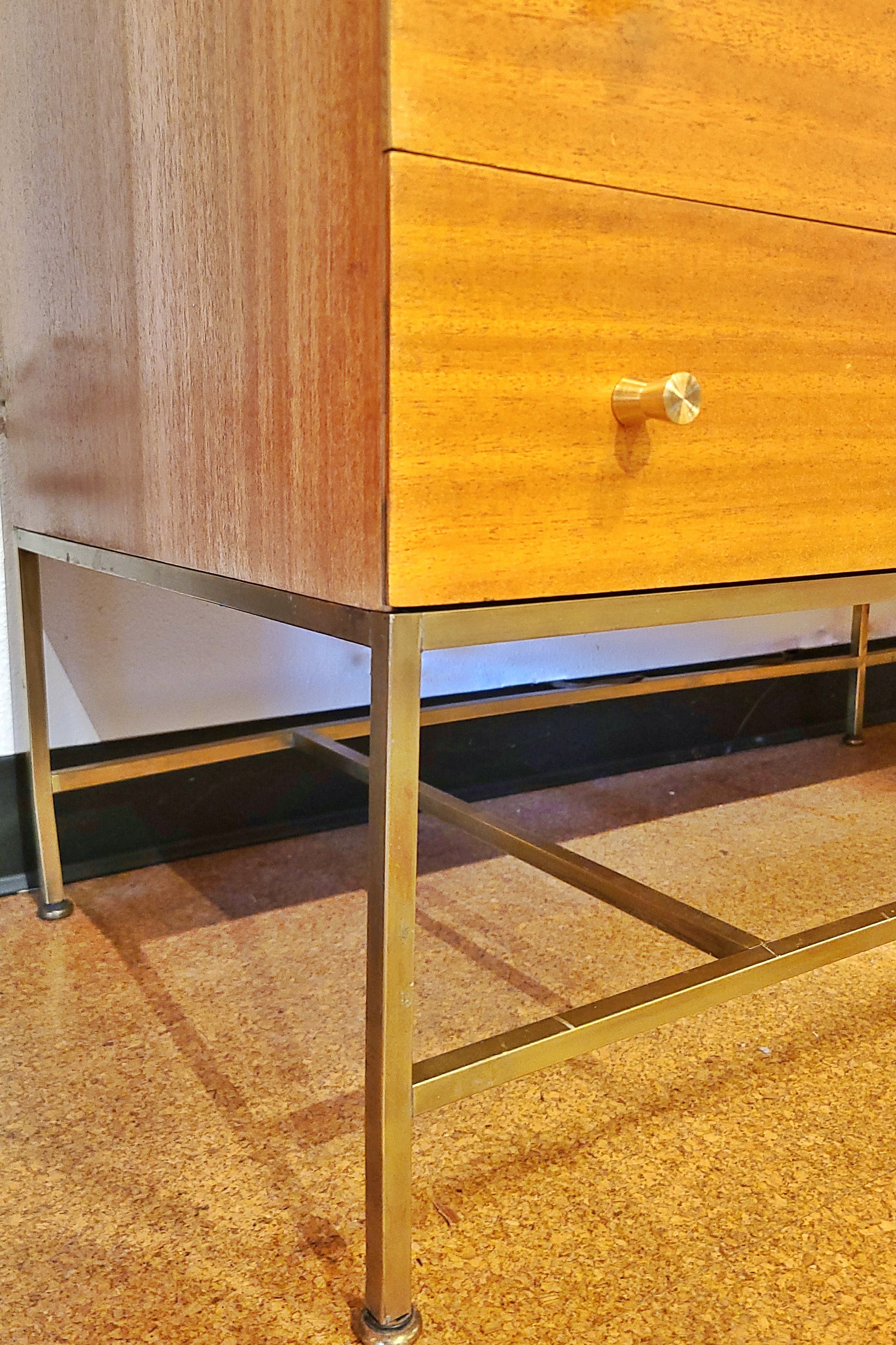
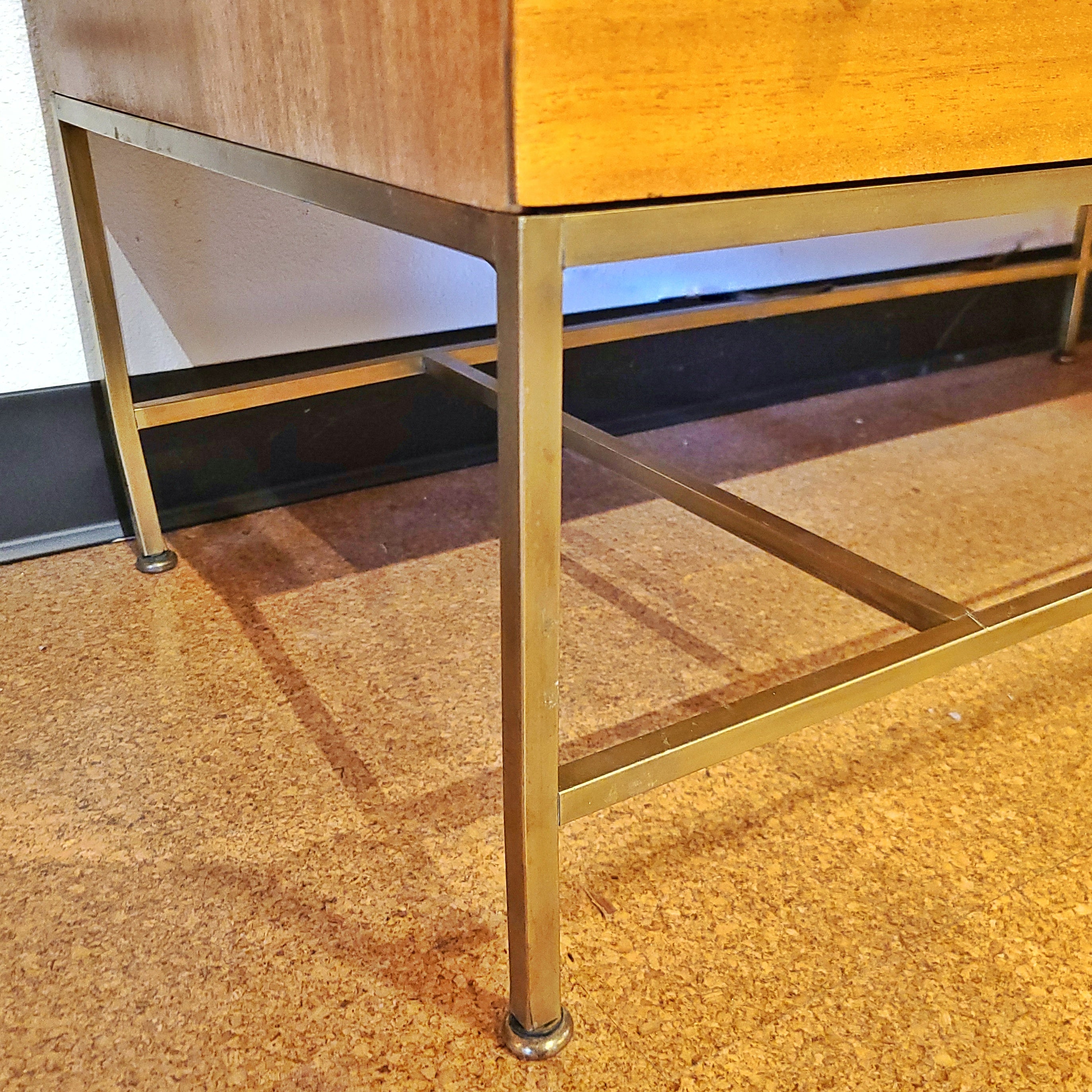
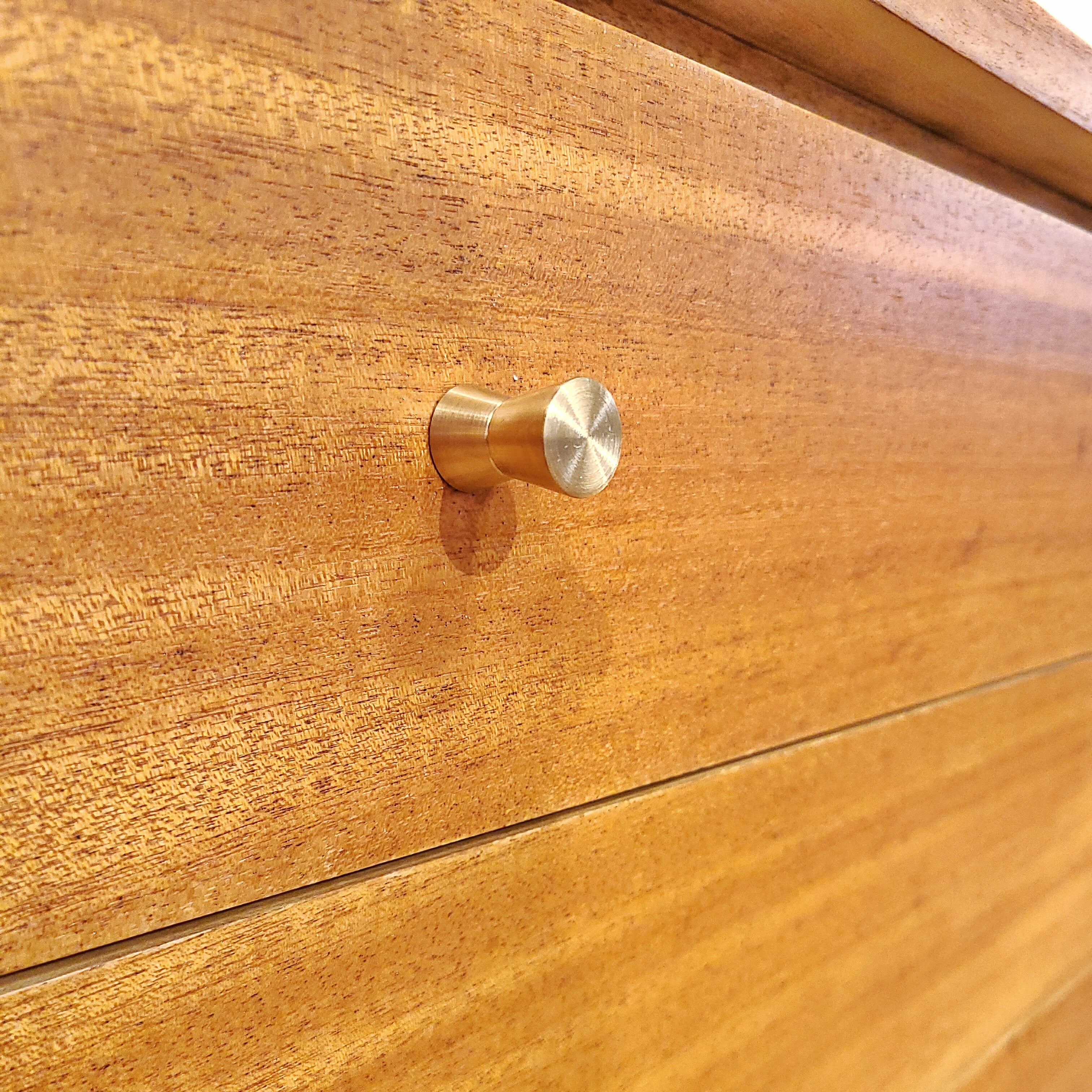
PAUL McCOBB ‘IRWIN COLLECTION’ DOUBLE-DRESSER FOR CALVIN FURNITURE (1950s)
CONTACT US HERE ABOUT THIS ITEM.
A completely refurbished, bleached mahogany Irwin Collection double-dresser on a squared tubular brass base, with an approximation of the original drawer hardware. Irwin was designed by Paul McCobb in 1956 for CALVIN FURNITURE (1953-1973) of Grand Rapids, Mich. As with many pieces produced with this base style, slight bends are expected—with no effect on structural integrity. This piece is in excellent vintage condition and is ready to place.
PAUL McCOBB (1917–1969) was a leading American furniture designer in the 1950s and ’60s. Despite a lack of formal training, he was responsible for an impressive range of furniture, textiles, and accessories. Born outside of Boston in Medford, Mass., in 1917, McCobb received an early education in painting under private tutelage before attending Boston’s Vesper George School of Art. After a brief stint during WWII in the camouflage unit of the US Army Corps of Engineers, he moved to New York City in 1945 and opened Paul McCobb Design Associates. The new firm quickly took on clients.
A commission with Modernage Furniture proved particularly advantageous, and McCobb rose to local prominence designing displays for the store’s in-house furniture line. He met employee Bernard G. “B.G.” Mesberg (1906—1977), a former furniture distributor from Milwaukee, on the sales floor; their animated conversations about a new kind of furniture—one that would embrace futuristic, industrial design on the one hand and mass production as a means of supplying high-quality, low-cost products to the middle-class housing market on the other—would ultimately give rise to the Planner Group. Released to retailers in 1949 and then to consumers in 1950, the collection would be among the best-selling furniture lines of the era. Under their contract, McCobb took charge of design and Mesberg was responsible for production and distribution.
McCobb was able to capitalize on the desires of young American families for simple, affordable, stylish furniture. His work was flexible, practical, and inexpensive, and his collections gave his buyers’ homes an instant “look.” He introduced the concept of “modular” furniture—and his “living walls,” with their moveable room dividers and storage systems, perfectly fit the evolving, informal lifestyles of mid-century America. Inspired by his New England upbringing and influenced by Shaker Design, McCobb's work combined slender lines with sculptural forms. He offered a playful take on traditional forms—with nods to Scandinavian craftsmanship and the clarity of International Style. The Planner Group embraced a minimalist aesthetic—easy to understand and easy to use. The collections that followed, including the Predictor Group for O'Hearn and the Directional Group for Winchendon, positioned McCobb to command a substantial market share. The Planner Group remained in production through 1964.
McCobb designed every imaginable home furnishing, including radios and televisions, kitchen cabinets, china, and textiles. He served as a consultant to many leading American corporations—Singer, Alcoa, Goodyear, Columbia Records, and Remington Rand—and traveled throughout America for speaking engagements, panel discussions, and talk show appearances. His syndicated design column appeared in newspapers across the country. He served as a visiting faculty member at the Philadelphia Museum School of Art.
McCobb was the recipient of MoMA’s Good Design Award five times between 1950 and 1955 as well as of the Philadelphia Museum of Arts’ Contribution to Better Design Award in 1959. His work can be found in the collections of the Brooklyn Museum, the San Francisco Museum of Modern Art, the Art Institute of Chicago, the Cleveland Museum of Art, and the Cooper Hewitt, Smithsonian Design Museum in Manhattan. After struggling with a long illness, McCobb died at the age of 51 in 1969.
His obituary in “The New York Times” referred to McCobb as the American designer. “By careful attention to detail, a selective use of materials, an analysis of function and a sensibility for balance and scale, Mr. McCobb provided post-World War II Americans with a multitude of contemporary designs for the home that fulfilled esthetic and budgetary requirements.”
Contemporary American design is not the Chinese influence, the Swedish or the Italian influence. It is an American influence that has an American look about it and has the feeling of belonging in our homes. Such design fits the size and shape of our rooms. – PAUL McCOBB
CALVIN FURNITURE COMPANY of Grand Rapids, Mich., opened its doors in 1953 and quickly gained recognition as a premier contract manufacturer for leading American furniture designers and brands of the mid-century era. The company's stylish modern and Hollywood Regency pieces were prominently featured in department store showrooms across North America throughout the 1950s and 1960s.
In its very early days, CALVIN partnered with Paul McCobb, the American furniture designer, well known for sleek, minimalist designs drawing on Shaker simplicity and Bauhaus minimalism. McCobb, in partnership with New York furniture salesman B.G. Mesberg, set up the Directional Furniture Company in Manhattan in 1949 and subsequently contracted with CALVIN to produce its designs.
Among the most acclaimed McCobb lines produced by CALVIN were the Calvin Group and the Irwin Collection. The company also manufactured the popular American Design Foundation furniture line designed by Kipp Stewart and Stewart MacDougall. That duo’s dining chairs, tables, and coffee tables flaunt their collection‘s clean lines, gentle curves, and organic shapes.
CALVIN FURNITURE continued its business relationship with McCobb via B.G. Mesberg National Sales and Directional Furniture through the late 1950s and early ‘60s. CALVIN finally closed its doors in 1973, but its enduring legacy can be found in the pieces of modern furniture that remain popular today.
DETAILS
Designer – PAUL McCOBB
Design Period/Year – 1956
Maker – CALVIN FURNITURE
Production Period/Year – 1950s
Origin – USA
Styles/Movements – MID-CENTURY MODERN
Materials – MAHOGANY, BRASS
Colors – AMBER, BRASS
Condition – Excellent, restored vintage condition. May show minor traces of wear consistent with age and use.
Dimensions – 60" W × 18" D × 30" H


